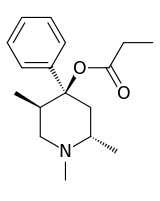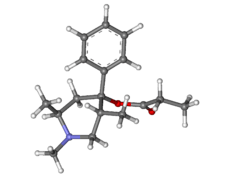Trimeperidine
Trimeperidine (Promedol) is an opioid analgesic that is an analogue of prodine. It was developed in the early 1950s in the USSR during research into the related drug pethidine.[1]
 | |
 | |
| Clinical data | |
|---|---|
| Other names | Trimeperidine, Promedol |
| AHFS/Drugs.com | International Drug Names |
| ATC code | |
| Legal status | |
| Legal status |
|
| Identifiers | |
| |
| CAS Number | |
| PubChem CID | |
| ChemSpider | |
| UNII | |
| ECHA InfoCard | 100.000.531 |
| Chemical and physical data | |
| Formula | C17H25NO2 |
| Molar mass | 275.392 g·mol−1 |
| 3D model (JSmol) | |
| |
| |
| | |
Trimeperidine has four structural isomers, of which two are active, the γ isomer trimeperidine, and the β isomer isopromedol.[2] It is around half the potency of morphine as an analgesic,[3][4] and has been widely used for the treatment of pain.[5][6]
Trimeperidine produces similar effects to other opioids, such as analgesia and sedation, along with side effects such as nausea, itching, vomiting and respiratory depression which may be harmful or fatal.
Trimeperidine is in Schedule I of the Controlled Substances Act 1970 of the United States as a Narcotic with ACSCN 9646 with an annual aggregate manufacturing quota of 2 grammes as of 2014. The free base conversion ratio for salts includes 0.883 for the hydrochloride. Promedol increases the activity of the reticular activating system in the brain.[7] It is listed under the Single Convention for the Control of Narcotic Substances 1961 and is controlled in most countries in the same fashion as is morphine or heroin.
References
- Назаров И. Н., Простаков Н. С., Швецов Н. И.ЖОХ , 1956, 26, 2798
- Casy AF, McErlane K. Analgesic potency and stereochemistry of trimeperidine and its isomers and analogues. Journal of Pharmacy and Pharmacology. 1971 Jan;23(1):68-9.
- Guseva EN. Comparative analgesic effects of promedol, phenadone, tecodine, and morphine. (Russian) Farmakologiia i Toksikologiia. 1956;19(Suppl):17-8.
- Bender KI, Gerasimova OV. Relationship between the pain-relieving action of narcotic analgesics and their effect on respiration. (Russian) Farmakologiia i Toksikologiia. 1976 Sep-Oct;39(5):552-6.
- Chernukha EA, Rasstrigin NN. Anesthesia in labor. (Russian) Fel'dsher i Akusherka. 1980;45(6):21-7.
- Zhirkova IuV, Stepanenko SM, Butyleva OIu, Zilbert EV, Manerova AF, Golodenko NV. Method of continuous intravenous postoperative analgesia with promedol in newborn children. (Russian) Anesteziologiia i Reanimatologiia. 2004 Jan-Feb;(1):12-6.
- http://www.deadiversion.usdoj.gov/fed_regs/quotas/2014/fr0825.htm